As early as 1936 the Government gave careful consideration to the question of marking the Dominion's centenary in 1940.
Issue information
A list of suitable subjects that could be depicted on a stamp issue was produced and 19 artists asked to submit design proposals. 58 designs were received with three by LC Mitchell (1/2d, 3d and 4d), and nine by J Berry being selected for use on the stamps.
Acknowledgments
New Zealand Post would like to acknowledge the following for their assistance and guidance in bringing together this stamp issue.
Historical Information
Information included on this page sourced from The Postage Stamps of New Zealand published by the Royal Philatelic Society of NZ. Their web site offers further information useful to those interested in the stamps and postal history of New Zealand. Link: https://www.rpsnz.org.nz/
Stamp Bulletin
Bulletin scanned and provided by John Biddlecombe of the New Zealand Society of Great Britain. Their web site offers further information useful to those interested in the stamps and postal history of New Zealand. Link: http://www.nzsgb.org.uk/
Stamp Bulletin
This stamp issue first appeared in New Zealand Post Stamp Bulletin No. 1 on 8 February 1940.
Product Listing for Centennial
| Image | Title | Description | Price |
|---|---|---|---|
 |
Single Stamp |
Single 1/2d 'Landing of Māori in New Zealand' gummed stamp. Māori history was transmitted orally from generation to generation in pre-European times. A continuing examination of the traditions, archaeological, linguistic and cultural evidence, has discredited the 'great fleet theory' of the Māori arrival in New Zealand. The consensus among scholars now is that the Polynesians originally moved into the Pacific from the west, spread eastwards, and that the Māori came most recently from the eastern Pacific (that is from Tahiti or the Marquesas). They began to arrive here in small groups, starting more than 1,000 years ago, probably via islands to the north-east. The scene depicted on the stamp is an original conception by the artist of the arrival of one of the canoes. The Māoris have been pictured as arriving in a state of physical exhaustion, the inevitable consequence, despite their magnificent seafaring skills, of weeks spent in open canoes. |
1/2d |
 |
Single Stamp |
Single 1d 'Captain Cook's map of New Zealand with his ship the Endeavour in 1769' gummed stamp. The first voyage of discovery by Captain Cook made the most important contribution to 18th century knowledge of the Pacific Ocean. From September 1769 the crew of the Endeavour began to encounter signs of land - seaweed, pieces of wood, seals and birds - two weeks later land was sighted from the masthead, bearing west by north. At sunset the land could just be seen from the deck. Cook's circumnavigation of the coast of New Zealand and his remarkably accurate survey, the product of which is his chart (reproduced in the stamp) ensured New Zealand a place on the map of the world. The central portion of the design shows HM Bark Endeavour, the vessel in which Cook made his voyage, a reproduction of his chart, and his portrait taken from the statue executed in bronze by Sir Thomas Brock and erected near the Admiralty Arch in London. |
1d |
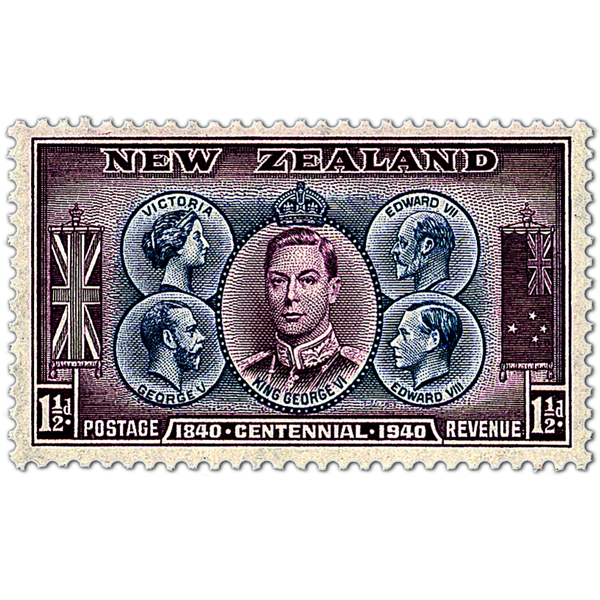 |
Single Stamp |
Single 1 1/2d 'British Sovereigns of New Zealand' gummed stamp. The design for this stamp was an original idea of Mr Berry, and was intended not only to depict historically the five Sovereigns who had reigned during New Zealand's first 100 years, but also to symbolise the unswerving loyalty of New Zealanders individually and collectively to the British Throne. |
1 1/2d |
 |
Single Stamp |
Single 2d 'Abel Tasman' gummed stamp. On 13 December 1642 Abel Tasman, one of the most capable captains in the service of the Dutch East India Company, sighted the New Zealand coast from his ship the Heemskercq. The billowing surf and rocky shore made landing impossible and he altered course to the north and sailed up the coast. Tasman, who had left Batavia in August 1642, accompanied by a fly boat, the Zeehaen, was engaged in a search for new and profitable lands with which his Company might trade according to the custom of that day. He thought the land sighted was part of 'Staten Land' but the country was subsequently named after the Netherlands province, Neiuw Zeeland (New Zealand). |
2d |
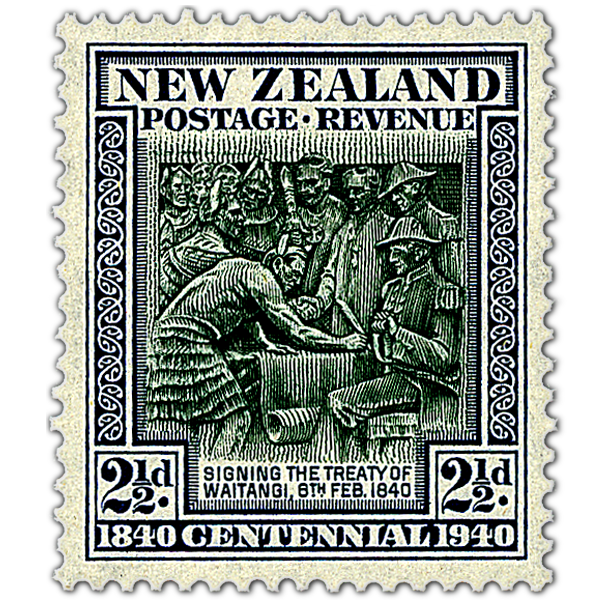 |
Single Stamp |
Single 2 1/2d 'The Signing of the Treaty of Waitangi' gummed stamp. The Treaty of Waitangi is considered by Māori and European alike as the supreme event in New Zealand history. It has gained its pre-eminence not only from the actual content of the agreement but because it formed the basis of the spirit of harmony which exists in New Zealand today between the Māori and the pākehā (European settlers). On 5 February 1840 a mass meeting was held on the north bank of the Waitangi River mouth, and the aim and purpose of the Treaty were explained to the Māori. The next day the chiefs signified their willingness to accept the conditions, and 46 paramount chiefs either signed the Treaty or affixed their mark. |
2 1/2d |
 |
Single Stamp |
Single 3d 'Settlers disembarking at Petone Beach' gummed stamp. The early history of New Zealand is closely interwoven with the activities of the New Zealand Association, which was formed in London in 1837 to buy land from the Māori for the settlement of emigrants from England. The Aurora, the first of the emigrant ships to arrive, tacked against an unfavourable wind and later anchored near Somes Island. A small jetty had been run out from the beach by the surveyors, and the 148 immigrants and 21 cabin passengers disembarked. Tents were pitched and huts erected and the settlement called Britannia was formed. The settlement lay at the western end of the sandy beach (Petone) which spread out for about two miles eastward from the Korokoro steam. The other emigrant ships, Oriental, Duke of Roxburgh and Bengal Merchant arrived at Petone between 22 January and 28 February. |
3d |
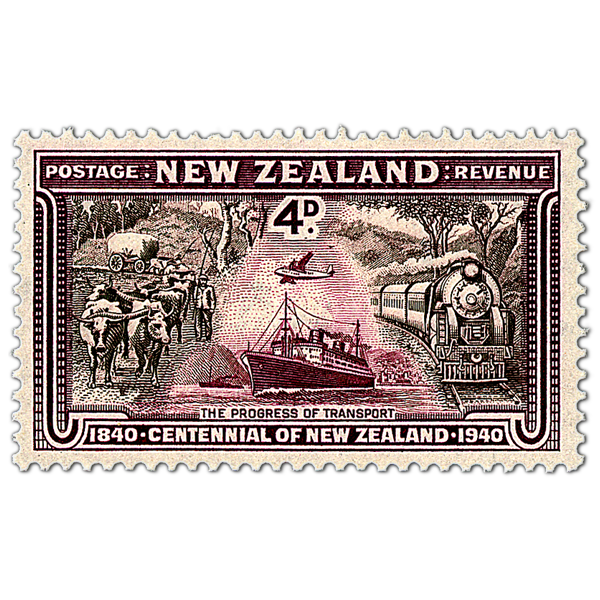 |
Single Stamp |
Single 4d 'Transport - Land, Sea and Air' gummed stamp. The primary problem in the development of a new country is the provision of transport facilities, and New Zealand was no exception in this respect. In the early days when roads were practically non-existent bullock and horse teams were used. Gradually, roads were developed, firstly for the use of the coach lines and ultimately for motor vehicles. Railways have been of considerable assistance in the economic development of the country. With its geographical position and its dependence on world markets for the sale of its primary products, safe and reliable transport to overseas markets has always been essential, first with sailing ships next with steam and motor ships and in recent times with air-transport. |
4d |
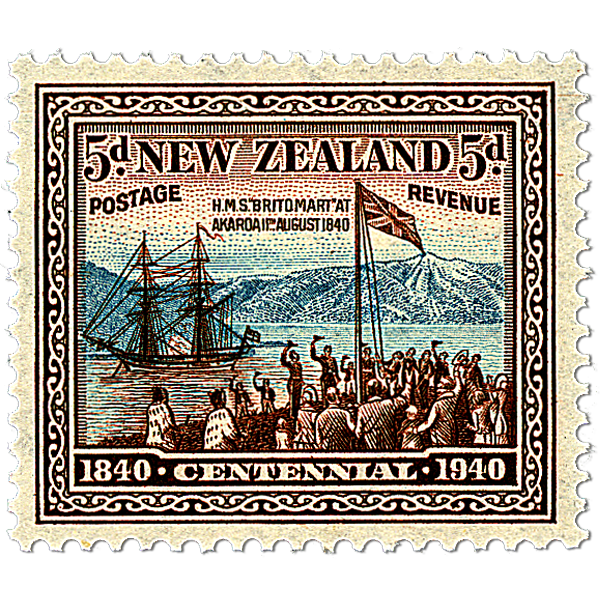 |
Single Stamp |
Single 5d 'Hoisting of Flag at Akaroa' gummed stamp. The hoisting of the British flag at Akaroa on 11 August 1840 marked the reassertion of British Sovereignty over the South Island. HMS Britomart was hurriedly dispatched from the Bay of Islands when rumours spread of a possible French attempt at annexation. Akaroa was a French settlement at the time. |
5d |
 |
Single Stamp |
Single 6d 'Dunedin's first voyage with a shipment of frozen mutton for the United Kingdom' gummed stamp. Although crop production was the predominant type of farming in New Zealand in the early days of the colony, the greater part of the farm lands were more suited to the growing of pasture grasses than to crop cultivation. With the development of refrigerating equipment pastoral production expanded to provide food for livestock as the export of frozen mutton and beef grew to be one of the most important industries. |
6d |
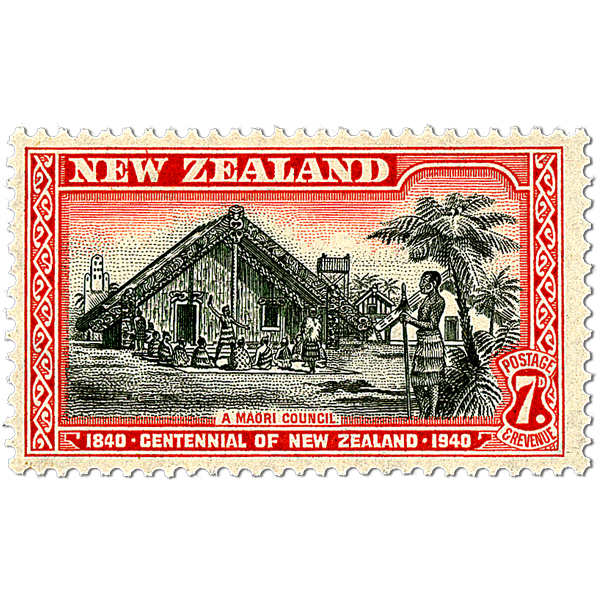 |
Single Stamp |
Single 7d 'Māori Council' gummed stamp. The Māori Council was an important unit in the social organisation of the Māori race. The Councils were held in front of the meeting house, and the solemnity of the assembly was carefully observed. Members of the Council addressed the assembly and the meetings provided many instances of brilliant Māori oratory. |
7d |
 |
Single Stamp |
Single 8d 'Māori Council (issued 8 March 1940)' gummed stamp. In October 1939, because of the outbreak of war, postal rates were altered and the 7d value was no longer required whereas the 8d was found necessary for use on parcels. It was therefore decided to issue the 8d in the same design as the 7d. A cable was sent to London requesting that the necessary die and plates should be made. |
8d |
 |
Single Stamp |
Single 9d 'Gold Mining' gummed stamp. The lure of gold is universal, and the mass fever which it produced in the 1850s had considerable effect on the development and the destinies of the newly settled countries of the Southern Hemisphere. The first discoveries of gold in New Zealand were made in 1852, but gold mining did not become of prime importance until 1861 when Gabriel Read discovered in Otago an alluvial field of great richness. This became known as Gabriel's Gully. Gold was found later in Westland. |
9d |
 |
Single Stamp |
Single 1s 'A Giant Kauri - "Tāne Mahuta" God of the Forest '-gummed stamp. One of the most magnificent specimens of the New Zealand kauri. This tree, in the Waipoua Forest Reserve in Northland, is 12.8 metres in circumference at the base and rises with little taper 25 metres before the first branch. |
1s |
Technical information
| Date of issue: | 2 January 1940 |
|---|---|
| Designers: | L C Mitchell, Wellington and J Berry, Wellington |
| Printer: | Bradbury Wilkinson, England |
| Stamp size: | 1/2d, 1, 1 1/2d, 2d, 3d, 4d, 6d, 7d, 8d and 9d : 40mm x 24mm; 21/2d : 24mm x 28mm; 5d : 27mm x 24mm; 1s : 24mm x 40mm |
| Sheet size: | 1/2d, 1d, 1 1/2d, 2d, 3d, 4d, 6d, 7d. 8d, 9d and 1s : 120 stamps per sheet; 2 1/2d and 5d : 160 stamps per sheet |
| Process: | Recess printed - Intaglio |
| Perforation gauge: | 2 1/2d : 14 x 13.5; 5d : 13.5 x 14; Other values : 13.5 |
| Paper type: | Wiggins Teape unsurfaced, NZ and star watermark. |

